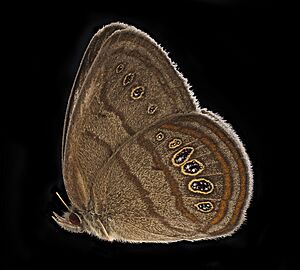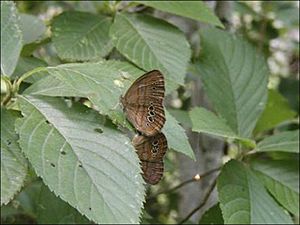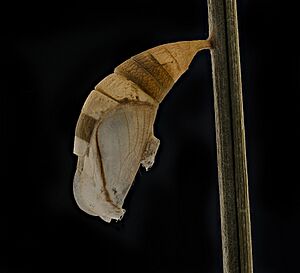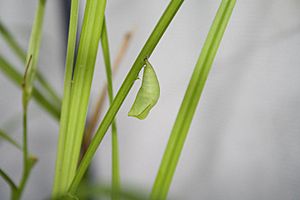Saint Francis' satyr facts for kids
Quick facts for kids Saint Francis' satyr |
|
|---|---|
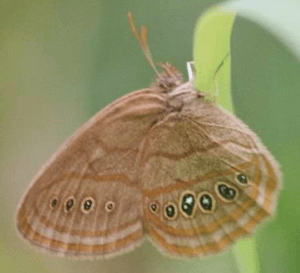 |
|
| Conservation status | |
| Scientific classification |
|
| Kingdom: | Animalia |
| Phylum: | Arthropoda |
| Class: | Insecta |
| Order: | Lepidoptera |
| Family: | Nymphalidae |
| Genus: | Neonympha |
| Species: |
N. mitchellii
|
| Subspecies: |
N. m. francisci
|
| Trinomial name | |
| Neonympha mitchellii francisci Parshall & Kral, 1989
|
|
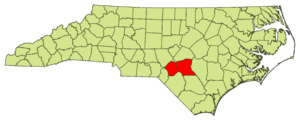 |
|
| NC range by county in red | |
The Saint Francis' satyr (Neonympha mitchellii francisci) is a very rare butterfly. It is a type of butterfly found only in North Carolina, USA. Scientists first found this butterfly in 1983. It was officially named in 1989. In 1994, the US government said it was an endangered species. This means it is at high risk of disappearing forever.
The Saint Francis' satyr lives only on the Fort Bragg military base. This base is in Hoke and Cumberland counties. It is a subspecies of the Mitchell's satyr butterfly. The Mitchell's satyr is also an endangered species.
Contents
What Does the Saint Francis' Satyr Look Like?
The Saint Francis' satyr is a small, dark brown butterfly. Its wingspan is about 34 to 44 millimeters (1.3 to 1.7 inches). It has special markings called eyespots on the underside of its wings. These eyespots are dark brown or maroon with yellow rings. They also have shiny white flecks in the middle.
There are two bright orange bands on the lower edges of its wings. Two darker orange bands cross the middle of each wing. Female butterflies are usually a bit bigger and lighter brown than males. This difference between males and females is called sexual dimorphism.
Life Cycle and Reproduction
Adult Saint Francis' satyr butterflies live for only about three to four days. They have two breeding periods each year. This is called being bivoltine. The first flight happens from late May to early June. The second flight is from late July to mid-August.
Females lay their eggs one by one or in small groups. The eggs hatch into larvae (caterpillars) in about seven to ten days. Caterpillars that hatch in early summer turn into a chrysalis after two months. Caterpillars that hatch later in the summer sleep through winter. They become a chrysalis the following spring. The chrysalis stage can last up to two weeks. Scientists are still learning a lot about this butterfly's life cycle.
What Do They Eat?
The caterpillars of the Saint Francis' satyr eat a plant called Mitchell's sedge (Carex mitchelliana). They probably also eat other types of sedges in the Carex family.
Adult butterflies mainly drink nectar from flowers and sap from trees. They also eat things like animal waste, pollen, and rotten fruit. They are often attracted to salt, which is why they might land on human skin to get sweat.
Where Do They Live?
The Saint Francis' satyr was first found in North Carolina in 1980. For a while, many thought the butterfly had died out. But it was found again in 1992. Today, these butterflies live only on the Fort Bragg military base. This base is in Cumberland and Hoke counties, North Carolina.
Even though Fort Bragg is a very large military base, the butterflies live in a small area. This area is only about 10 square kilometers (3.38 square miles). In the past, there were several small groups of these butterflies. Now, there is only one main group left. The butterfly has never been found living anywhere else outside of Fort Bragg.
What Kind of Home Do They Need?
The Saint Francis' satyr lives in open grasslands, wetlands, and areas with lots of sedge plants. These places need regular natural changes to stay healthy. These changes can come from beaver dams, natural fires, heavy rain, or floods. The butterfly needs these changes to create the wet meadows it needs to survive.
The military training at Fort Bragg also helps create these wet meadows. The regular activities on the base cause disturbances that help keep the butterfly's habitat in good shape.
How Many Are There?
We don't know much about how many Saint Francis' satyr butterflies there were in the past. From 2002 to 2005, scientists thought there were between 500 and 1400 butterflies. Their living areas are small, ranging from 0.2 to 2.0 hectares (about half an acre to five acres).
Today, it's thought that there are no more than 1000 butterflies in total. No single group has more than 100 butterflies in a year. The number of butterflies has gone down over the years. This might be because people stopped natural fires and removed beavers, which changed their habitat.
Why Are They Endangered?
The Saint Francis' satyr was listed as endangered in 1994. This happened because of threats like illegal collecting and losing their habitat. Since then, efforts have been made to stop people from collecting these butterflies. However, illegal collecting is still a problem because the butterfly is so rare. To help, the exact locations of butterfly groups are kept secret.
From 1998 to 2016, over $3 million was spent on helping the Saint Francis' satyr. The main goal is to protect and help the existing butterfly groups grow. Also, strict rules against collecting them are enforced.
Main Threats to the Butterfly
The Saint Francis' satyr faces several threats that put it at risk.
- Loss of Habitat: The butterfly has lost much of its home. This is due to changes in the environment over the last 100 years. For example, hunting beavers and stopping natural fires have reduced the wet meadow habitats they need. Experts believe the butterfly used to live in a much larger area.
- Over-collecting: People used to collect too many of these butterflies for fun or to sell. This was a big threat when the butterfly was first listed as endangered because it was so rare.
- Other Factors: The butterfly does not move far, which makes it hard for new groups to form. Natural events like storms can also wipe out small groups. Also, having less variety in their genes makes them more likely to get sick.
Human activities near their habitat also cause problems. Things like chemical spills from roads, pest control for mosquitoes, and stopping fires can harm them. However, living on the Fort Bragg military base helps them. The frequent military activities create disturbances that help make the meadows they need.
What Is Being Done to Help?
Scientists want to change the Saint Francis' satyr's status from endangered to threatened. This can happen when their main group has grown or stayed stable for 10 to 15 years. Also, there needs to be a long-term plan to help them survive.
Rules to Protect Them
Laws now stop people from selling, importing, exporting, or removing the Saint Francis' satyr. This helps reduce collecting. Federal agencies are also not allowed to do things that would harm the butterflies. This includes building roads, using pesticides, or controlling beavers in their habitat. North Carolina now has laws to protect these butterflies and their homes.
Recovery Plan
The recovery plan aims to improve conditions for the Saint Francis' satyr. The goal is to get them off the endangered list. A healthy group would have about 200 adult butterflies per breeding period.
- Protecting Their Homes: This part of the plan focuses on three things.
- Watching the Butterflies: Since 2002, scientists have been counting the butterflies in their living areas.
- Keeping Them Safe: Researchers keep the butterfly locations secret. They also limit military traffic near where the butterflies live.
- Managing for the Future: Scientists are creating plans to keep the habitat healthy. This involves making sure the land gets the disturbances it needs, like controlled fires.
- More Research: There is still much to learn about this butterfly. Scientists are working with North Carolina State University and the Department of Defense. This research helps them understand how the butterfly population changes and how it uses its habitat.
- Finding New Groups: Researchers have found three new groups of butterflies. However, all of them are still on Fort Bragg. Their locations are kept very secret, making it hard to check on their health.
- Creating New Wild Groups: This involves raising butterflies in special programs and then releasing them into new safe areas. As of 2013, no new groups had been fully set up in the wild. However, some areas were prepared in 2011 to possibly house new butterflies.
- Teaching Others: It is important to teach the public about the butterfly. This helps stop illegal collecting. It also encourages landowners to turn their land into suitable butterfly habitat.
Since the Saint Francis' satyr is still endangered, the plan suggests continuing these efforts. They need to keep protecting existing habitats and create new ones for the butterflies.
Taxonomy
After it was discovered, the Saint Francis' satyr was classified as a subspecies of the Mitchell's satyr (Neonympha mitchellii). The main Mitchell's satyr subspecies, N. m. mitchellii, lives in different parts of the central and eastern US. This includes Michigan, Alabama, Mississippi, and Virginia. It used to live in New Jersey too.
Even though some populations in Alabama, Mississippi, and Virginia look similar to the Saint Francis' satyr, genetic tests show they are different. The Saint Francis' satyr is still considered a separate subspecies. Scientists are even looking into whether it should be its own full species.
Images for kids



